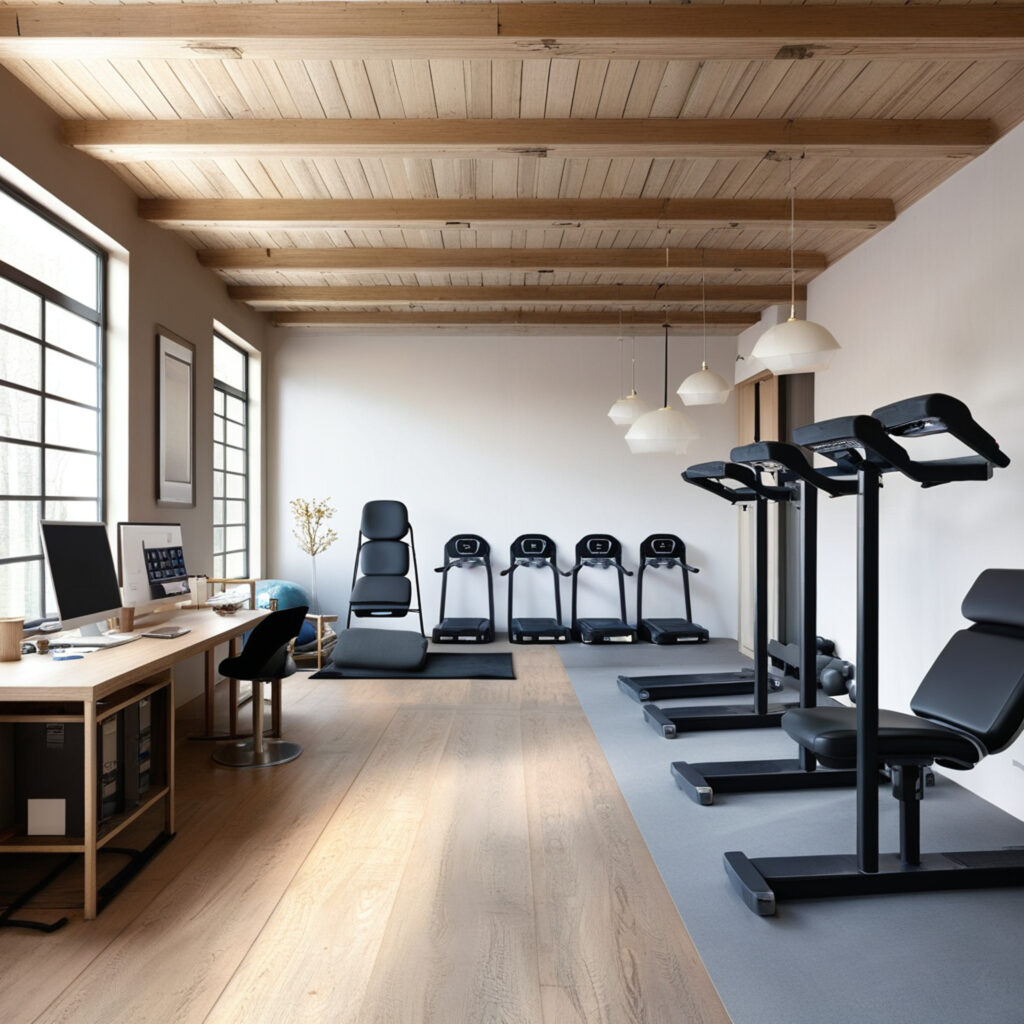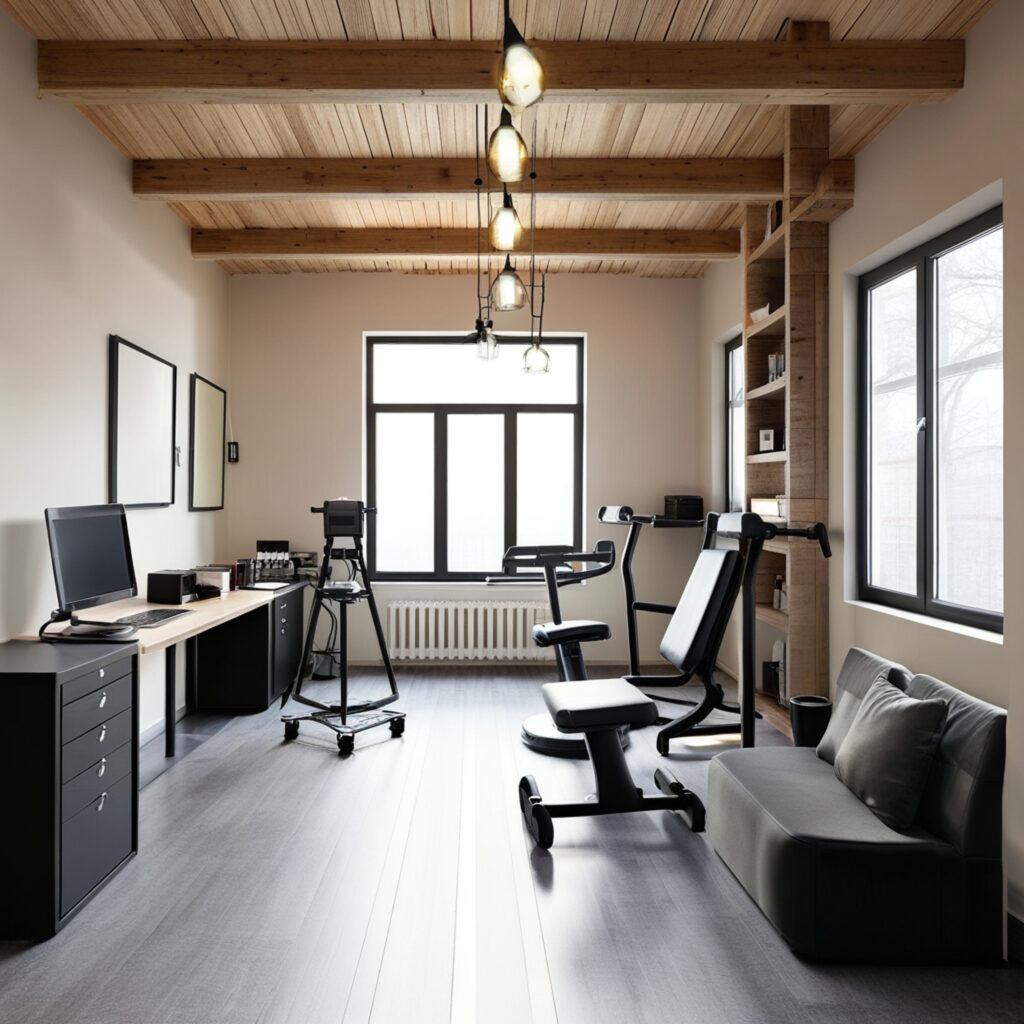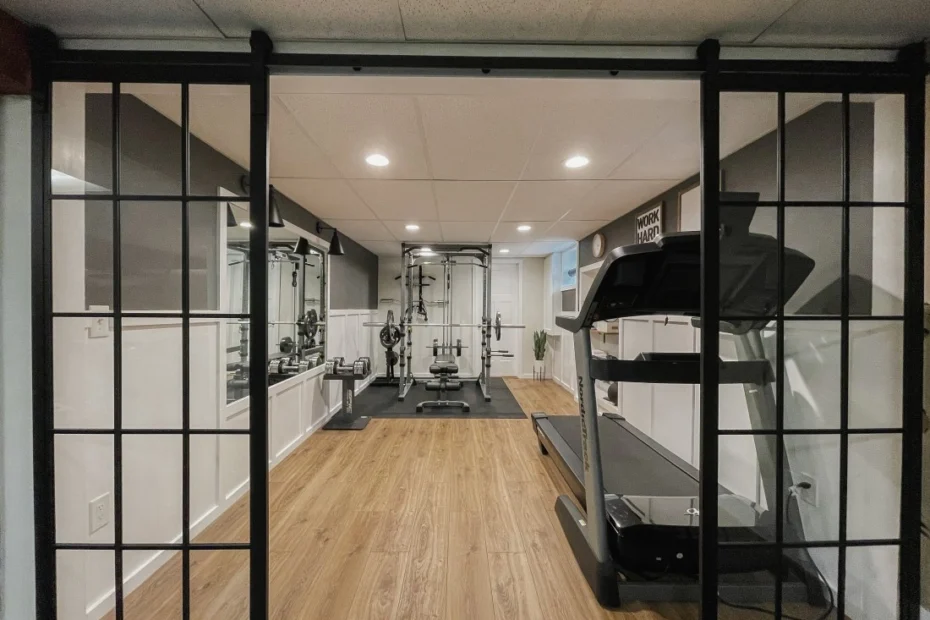Converting your basement into a home gym does more than add extra space—it creates a personal fitness sanctuary right in your home. A finished basement home gym works as an entertainment hub, workout space, and storage solution all at once.
Our basement gym planning taught us that attention to fundamentals makes all the difference. Every design choice matters, from thoughtful home gym layout planning to smart workout room ideas. The right flooring selection is significant because basement floors face unique challenges—moisture, heavy traffic, and dropped weights all in one day. Materials like vinyl plank and rubber tiles have become our top choices for home gym setup ideas.
This piece walks you through design strategies that create a basement gym with both function and style. These tips will help you build a space that works better and lasts longer, whether you want to complete your project by a specific date (like our goal to finish by early August for my son’s friends before school starts) or just want to discover your basement’s full potential.
Plan Your Layout with Purpose
A well-thought-out layout makes the difference between a basement gym you’ll actually use and one that becomes a storage space. Smart planning before buying equipment will help you create the perfect workout space.
Define your zones: gym, lounge, and storage
Your basement becomes more functional when you break it into designated zones. You should think about three main areas: a workout zone for equipment, a lounge area for recovery, and a storage section for gear. This approach helps keep things in order and creates a structured environment for exercising. The gym works better when you separate specific sections for cardio, strength training, and stretching. This setup allows better workouts and keeps equipment well-organized.
Measure and map out your space
A measuring tape and a notebook should be your first tools. Write down wall dimensions, ceiling height, and mark any odd corners or obstacles. Knowing your available square footage helps you see where equipment will fit best. This prevents the headache of finding out your new treadmill won’t fit in its planned spot. A versatile gym with areas for cardio, strength training, and floor exercises needs at least 200-300 square feet of space.
Consider ceiling height and ventilation
You can’t compromise on ceiling height for certain exercises. Most workouts need at least 7 feet of clearance. Weightlifting or using a power rack requires 8-9 feet to safely do overhead movements. You’ll want 9-10 feet if possible for jumping exercises or TRX-style suspension training. Good ventilation matters just as much. Basement gyms get stuffy and humid quickly. Ceiling fans, vents, or a dehumidifier help control moisture, stop mold growth, and keep air fresh during intense workouts.
Use a home gym layout planner or app
Digital planning tools help you avoid expensive mistakes. Gym layout apps show your space in both 2D and 3D before you buy anything. You can try different equipment arrangements, check clearances, and see how your finished space will look. These apps come with large product libraries. You can drag and drop gym equipment into your virtual layout.
Choose Flooring That Works for Both Fitness and Comfort

Your basement home gym needs the right flooring as its base. The next big decision after planning your layout is picking the right flooring material that works well and feels comfortable.
Vinyl plank vs. rubber tiles
You should think over your workout style when choosing between vinyl plank flooring and rubber tiles for basement gym ideas. Rubber flooring stands out for durability, shock absorption, and resistance to impact. This makes it perfect for weightlifting and equipment areas. Luxury vinyl flooring gives you a water-resistant and realistic wood-like look while staying durable. But rubber does a much better job at cutting down noise and absorbing vibrations—these factors matter a lot in basement workouts.
Moisture resistance and durability
You can’t compromise on moisture control for basement gym setups. The best basement gym flooring should keep the cold out, protect your joints, handle moisture, and shield the concrete below. PVC tiles that are waterproof create a raised floor system to keep your workout surface dry above damp concrete. If you lift weights, pick flooring at least 3/4-inch thick to handle barbells and large free weights.
Using rugs to define zones
Rugs can help you create visual boundaries in multi-purpose basement gyms. Low-pile or printed rugs add softness and warmth while marking different workout areas. Indoor/outdoor rugs handle wear and tear well and clean up easily—perfect for busy gym zones. Smart rug placement helps mark the shift between workout and relaxation spaces.
Avoiding gym-specific flooring mistakes
Bad flooring choices can hurt your basement gym’s usefulness. Watch out for these mistakes:
- Trying to save money by skipping proper gym flooring
- Setting up equipment on uneven surfaces, like carpet, that throws off balance
- Buying all your equipment first, then running out of money for good flooring
- Using basic flooring for specific activities (like deadlifting without rubber protection)
Note that different types of workouts need different flooring. Rubber rolls work great for general fitness and give you smooth coverage with few seams. If you do aerobics and dynamic moves, look into plyometric rubber flooring that cushions better.
Lighting and Design That Elevate the Space
Good lighting can turn a simple basement gym into an inspiring fitness sanctuary. A workout space needs careful illumination that helps you exercise safely and stay motivated.
Layered lighting: ambient, task, and accent
The best basement gym lighting combines three distinct layers. Ambient lighting lights up the entire space and helps you move around safely. Bright, evenly spread overhead LED fixtures at 5000K-6000K color temperature create daylight-like conditions that boost your energy and physical performance. Task lighting focuses on specific workout zones like weight racks or cardio equipment, where you need to see clearly. Accent lighting makes architectural features, motivational quotes, or equipment stand out and creates a professional atmosphere.
Using mirrors to reflect light and expand space
Mirrors serve two purposes in basement gyms. Mirrors reflect both natural and artificial light when placed strategically and brighten dim basement spaces quickly. They also make the room look bigger, which helps a lot in smaller workout areas. You can amplify brightness by placing mirrors opposite light sources. Mirror-enhanced lighting, with fixtures above or around mirrors, spreads light evenly across the room.
Color schemes that energize and relax
Wall colors affect workout psychology by a lot. Vibrant reds and oranges raise your heart rate and energy levels in high-intensity zones. Blues and greens help you stay calm and focused—perfect for yoga or recovery areas. Neutral colors work well as backgrounds that match your equipment and let you add accent colors without overwhelming the space.
Smart lighting for workouts and movie nights
Smart LED lighting gives you amazing flexibility in multi-use spaces. These systems switch from bright white light (6000K) during intense workouts to warmer, dimmer tones (3500K) when you cool down. Some lights sync with music or workout videos to create immersive experiences. Smart controls let you save different lighting scenes—you can activate “workout mode” with one tap or voice command before easily switching to movie night settings.
Smart Storage and Equipment Choices

Smart storage can turn a cramped basement workout area into a functional multi-use space. A vertical approach and versatile equipment choices help modest basements support serious fitness goals.
Wall-mounted racks and foldable benches
Your basement gym needs vertical space. Wall-mounted storage racks keep equipment neatly stored and off the floor to create an open workout area. Pegboards offer customizable arrangements for accessories and are perfect for storing resistance bands, jump ropes, and smaller items. Heavy equipment needs wall-mounted storage solutions like barbell racks that prevent floor damage and keep pathways clear. Foldable benches and equipment help transform tight spaces—you can’t tuck these away after workouts to free up valuable floor space.
Hidden storage for weights and gear
Equipment needs to be tucked away between sessions to keep your basement tidy. Storage benches do double duty—they provide seating and hide accessories in hidden compartments. Cube storage units work great for weights, mini bands, and yoga blocks. The space under the stairs becomes triangular cubbies for rarely used items. Cabinet systems on wheels give you the flexibility to rearrange as needed if you want everything out of sight.
Multi-use furniture for the lounge and gym
Dual-purpose pieces make basement gyms more useful. Storage ottomans give you seating plus hidden space for small equipment. Some basement designs include Murphy beds with surrounding shelving that turn workout areas into guest rooms. Exercise ball chairs work as office seating and workout equipment. Ottoman lids that flip into stable surfaces offer ultimate flexibility.
Incorporating a mini fridge or refreshment area
A dedicated hydration station raises the bar in any basement gym. Mini fridges keep drinks and healthy snacks close by—especially when you need post-workout hydration. Some home gyms feature glass-door beverage fridges with built-in shelving above that hold protein supplements and glasses. A specific zone for smoothie preparation helps maintain proper nutrition during intense training.
Emergency prep and utility storage ideas
Basements store emergency supplies along with fitness equipment. Shelving near an exit works best to store emergency preparedness items. Waterproof storage bins protect safety supplies and emergency food. A dedicated section of your basement with shelving units can block utility areas from view and help you stay organized.
Conclusion
Building a basement gym needs careful planning, but you’ll find the results worth every bit of effort. This piece shows how good zoning, the right flooring, smart lighting, and storage solutions blend together. These elements create a versatile space that doesn’t compromise on any front.
A basement makes the perfect spot for your fitness sanctuary. It naturally keeps noise contained and usually has enough room for different types of workouts. On top of that, it can easily switch from an energizing workout space to a cozy entertainment area with the right design.
The best basement gyms strike a balance between function and comfort. You should plan your layout before buying equipment to avoid future headaches. The right flooring choice matters too – rubber tiles work great for weight areas while vinyl planks suit multipurpose spaces. Both options protect your concrete floor and your joints during tough workouts.
Good lighting can make your basement gym shine. A mix of ambient, task, and accent lighting creates a space that adapts to your needs throughout the day. Smart lighting systems take this flexibility up a notch. You can quickly switch between high-energy workout modes and relaxing settings.
Your storage choices determine how well the space works every day. Wall-mounted racks, foldable equipment, and multipurpose furniture keep things tidy while leaving plenty of floor space for actual workouts.
Your perfect basement gym doesn’t need complex or expensive solutions. Good planning and focus on these key elements will create a space you’ll want to use often. Remember – the best home gym is one that fits both your fitness goals and life’s other important moments.
